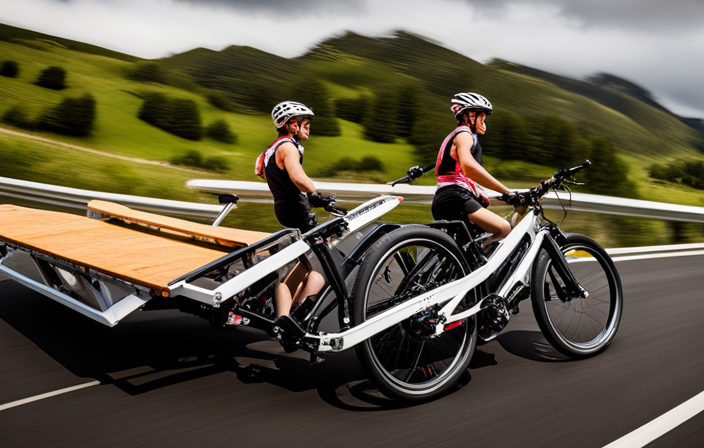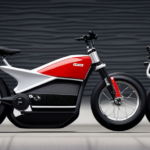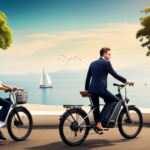As an avid electric bike rider, I’ve always been fascinated by the towing capacity of these innovative vehicles. Did you know that electric bikes have the potential to pull a significant amount of weight?
In this article, we will delve into the technical aspects of electric bike towing, exploring factors that affect performance and sharing real-life examples. Whether you’re using your electric bike for commuting or outdoor adventures, understanding its towing capabilities can greatly enhance your riding experience.
So, let’s dive in and uncover the hidden potential of electric bike towing!
Key Takeaways
- Factors such as motor power, frame strength, and towing accessories determine the towing capacity of an electric bike.
- Rider weight, terrain, and battery capacity are factors that affect the towing performance of an electric bike.
- Motor power and torque play a significant role in determining the towing capacity of an electric bike.
- Proper weight distribution, good control, adherence to traffic laws, and understanding limitations are crucial for safety when towing with an electric bike.
Understanding Electric Bike Towing Capacity
Electric bikes can’t tow heavy loads, but they do have a towing capacity. When it comes to carrying capacity, electric bikes have their limitations. However, with the right towing accessories, they can handle a decent amount of weight.
The towing capacity of an electric bike refers to the maximum weight it can safely pull without putting excessive strain on the motor and other components. This capacity is determined by factors such as the power output of the motor, the strength of the frame, and the overall design of the bike.
To enhance the towing capabilities of an electric bike, there are various towing accessories available in the market. These accessories include tow bars, trailers, and cargo racks, which provide additional support and stability when hauling heavy items. They are specifically designed to distribute the weight evenly and minimize the impact on the bike’s performance.
Factors that affect electric bike towing performance include the weight of the rider, the terrain, and the battery capacity. These factors can impact the overall performance and efficiency of the bike when towing heavy loads. By considering these factors and choosing the appropriate towing accessories, electric bike users can maximize their towing capacity and safely transport their belongings without compromising the bike’s performance.
Factors that Affect Electric Bike Towing Performance
When it comes to electric bike towing performance, there are several key factors that play a crucial role.
The motor power and torque determine the bike’s ability to handle heavier loads and maintain speed uphill.
The battery capacity and range are important for longer trips or when towing for extended periods, ensuring sufficient power to cover the distance.
Additionally, the frame and build quality should be sturdy and durable to withstand the added strain of towing.
Tire type and traction are vital for maintaining stability and grip on different terrains and gradients.
Motor Power and Torque
The motor’s power and torque determine how much weight an e-bike can pull. A more powerful motor will generally have a higher towing capacity, as it can generate more force to move the bike and the load. Similarly, a motor with higher torque will provide better acceleration and climbing ability, allowing the e-bike to handle heavier loads. However, it’s important to note that every e-bike has its own towing capacity limits, which are determined by factors such as the frame design and the strength of other components.
Understanding the motor’s power and torque capabilities is essential to ensure that you stay within the safe towing limits of your e-bike.
Moving on to the next section, let’s discuss the importance of battery capacity and range.
Battery Capacity and Range
To make sure you have enough power for your ride, it’s important to consider the battery’s capacity and range.
Battery performance is crucial in determining how far and how long you can ride your electric bike. The capacity of the battery refers to the amount of energy it can store, usually measured in watt-hours (Wh). The higher the capacity, the more power your bike can provide.
Range, on the other hand, indicates how far you can travel on a single charge. It depends on various factors such as terrain, rider weight, and speed.
Additionally, charging infrastructure plays a significant role in battery performance. Accessible charging stations and fast charging capabilities enable convenient and efficient recharging, enhancing the overall usability of the electric bike.
Considering these aspects ensures a satisfying riding experience.
In the next section, we will delve into the frame and build quality of electric bikes, which further contributes to their overall performance and durability.
Frame and Build Quality
Considering the frame and build quality is essential for ensuring a durable and high-performing electric bike. A sturdy frame can withstand the stress and weight of cargo, making it capable of carrying heavier loads. Here are four key factors to consider when evaluating frame and build quality:
- Material: Look for frames made from strong and lightweight materials like aluminum or carbon fiber.
- Design: Opt for frames with reinforced joints and welds for added strength and stability.
- Geometry: Choose a frame with a longer wheelbase and lower center of gravity to enhance stability and handling when carrying heavy loads.
- Mounting Points: Ensure the frame has ample mounting points for attaching cargo racks, panniers, and towing accessories.
By carefully considering these aspects, you can select an electric bike with a robust frame and build quality to maximize cargo capacity and accommodate towing accessories.
Now, let’s delve into the importance of tire type and traction.
Tire Type and Traction
Make sure you choose the right tire type and traction for optimal performance and grip on various terrains. When it comes to electric bikes, traction control is crucial for a smooth and safe ride. The right tire type and proper tire pressure can significantly enhance your bike’s ability to handle different surfaces. To help you understand the importance of tire type and traction, take a look at the table below:
| Tire Type | Terrain | Grip Level |
|---|---|---|
| Knobby | Off-road trails | High |
| Slick | Smooth pavement | Moderate |
| Hybrid | Mixed terrain | Balanced |
Terrain and Gradient
When riding on different terrains, the gradient can greatly impact the performance of your electric bike. This is especially true when it comes to towing on rough terrain or tackling steep slopes. Electric bikes are designed to provide assistance and make riding easier, but they do have their limitations.
Towing on rough terrain can put a lot of strain on the motor and battery, as the bike needs to work harder to maintain stability and traction. Similarly, towing on steep slopes requires more power and torque, which can drain the battery quickly. It is important to consider these factors when planning to tow or ride on challenging terrains, as it can affect the overall performance and range of your electric bike.
Transitioning into the next section about carrying cargo with an electric bike, it is important to note that the weight of the cargo also plays a significant role in the bike’s performance and range.
Carrying Cargo with an Electric Bike
You can easily carry cargo with an electric bike, and it’s important to know how much weight it can handle. When it comes to cargo weight and towing capacity, electric bikes have their limitations. Here are three key factors to consider:
-
Motor Power: The motor power of an electric bike directly impacts its towing capacity. A more powerful motor will be able to handle heavier loads. Look for electric bikes with higher wattage motors, as they are designed to handle greater weights.
-
Frame and Structure: The frame and structure of an electric bike play a crucial role in its ability to carry cargo. Opt for bikes with sturdy frames and reinforced components, as they provide better stability and support for hauling heavier items.
-
Load Distribution: Proper load distribution is essential for maintaining balance and control while carrying cargo. Distribute the weight evenly on both sides of the bike and secure it tightly to prevent any shifting during transit.
With these considerations in mind, you can confidently carry cargo on your electric bike. Now, let’s explore how electric bike towing can be beneficial for commuting and running errands without compromising on efficiency and convenience.
Electric Bike Towing for Commuting and Errands
Now let’s explore how electric bike towing can be beneficial for commuting and running errands without compromising on efficiency and convenience.
Electric bike towing is not just limited to carrying cargo; it can also be used for various recreational activities and pet transportation.
When it comes to commuting, towing a trailer with your electric bike allows you to effortlessly transport your belongings, whether it’s groceries, work equipment, or even your gym bag. The electric motor provides the necessary power to make towing a breeze, while still maintaining the efficiency and convenience of using an electric bike.
But electric bike towing is not just limited to practical purposes. It can also enhance your recreational activities. Whether you enjoy camping, picnicking, or going to the beach, towing a trailer with your electric bike enables you to carry all the necessary gear and equipment without the need for a car. This not only saves you money on gas and parking fees, but it also allows you to enjoy the outdoors in a more eco-friendly way.
Furthermore, electric bike towing can also be a great option for pet transportation. With the right trailer, you can safely and comfortably transport your furry friend while enjoying the benefits of electric biking. This is especially useful for older or injured pets who may struggle with long walks or for those who simply prefer to ride in style.
In the next section, we will explore electric bike towing for outdoor adventures and how it can open up a world of possibilities for exploring new terrains and conquering challenging trails.
Electric Bike Towing for Outdoor Adventures
Towing a trailer with your e-bike opens up a world of possibilities for exploring new terrains and conquering challenging trails. One of the key factors to consider when towing with an electric bike is its towing capacity. Electric bike towing capacity refers to the maximum weight that an e-bike can safely tow. This capacity varies depending on the specific model and design of the e-bike.
The benefits of electric bike towing are numerous. Firstly, it allows you to carry additional gear and supplies, making longer trips and outdoor adventures more feasible. Whether you’re planning a camping trip or a mountain biking excursion, having the ability to tow a trailer means you can bring all the necessary equipment without compromising on comfort or safety. Additionally, electric bike towing can provide an extra boost of power when tackling steep inclines or challenging terrain. The electric motor assists in moving the additional weight, making it easier to navigate through rugged trails.
However, it’s important to consider safety considerations for electric bike towing. Ensuring that the trailer is properly attached and balanced is crucial to maintaining stability and control. Additionally, braking distances may be affected when towing, so it’s important to allow for extra stopping distance. Understanding the limitations of your e-bike and trailer, as well as practicing proper riding techniques, will help ensure a safe and enjoyable towing experience.
Safety Considerations for Electric Bike Towing
When it comes to safety considerations for electric bike towing, there are several key points to keep in mind.
First, it’s crucial to distribute the weight properly to maintain stability and prevent tipping.
Second, braking and handling become even more important when towing a heavy load, so it’s essential to have good control over the bike.
Lastly, following traffic laws and regulations, as well as ensuring visibility and proper signaling, are vital for a safe and smooth towing experience.
Distributing Weight Properly
Properly distributing weight on an electric bike is important for maintaining stability and control. When it comes to balancing cargo load, it is crucial to consider the weight distribution on the bike.
Placing the majority of the weight towards the rear can cause the front wheel to lift, leading to a loss of control. On the other hand, having too much weight towards the front can make the bike feel unstable and difficult to maneuver.
The ideal position is to have the weight evenly distributed, with a slight bias towards the rear. This allows for better traction on the front wheel while maintaining stability.
By properly distributing the weight, riders can ensure a safer and more enjoyable experience while riding their electric bikes.
To ensure optimal braking and handling, it is important to consider the weight distribution of the cargo load.
Braking and Handling
To ensure optimal braking and handling, it’s important to remember that weight distribution plays a crucial role. Uneven weight can cause the bike to become unstable during braking, leading to a loss of control. By evenly distributing the load, you can maintain better balance and control while braking.
In addition to braking techniques, weight distribution also affects maneuverability. A well-balanced cargo load allows for smoother turns and easier maneuvering, enhancing your overall riding experience.
Remember, proper weight distribution is key to maximizing your electric bike’s braking and handling capabilities.
Ensuring your cargo load is evenly distributed is just one aspect of responsible riding. It’s also important to follow traffic laws and regulations. By obeying speed limits, using proper signaling, and respecting other road users, you can contribute to a safer and more enjoyable riding environment.
Following Traffic Laws and Regulations
Following traffic laws and regulations is crucial for ensuring a safe and enjoyable riding experience on your electric bike. Understanding traffic regulations is essential to navigate through various road situations. It is important to familiarize yourself with speed limits, stop signs, traffic signals, and right-of-way rules. By following these regulations, you can ensure road safety for yourself and others.
Always be mindful of other vehicles, pedestrians, and cyclists on the road. Use hand signals to indicate your intentions to turn or stop, and obey traffic signals accordingly. Maintaining proper distance from other vehicles and adhering to lane markings is also vital.
By understanding and following traffic laws, you can have a smooth and secure ride on your electric bike.
Now, let’s move on to the next section about visibility and signaling.
Visibility and Signaling
Make sure you always check your visibility and use proper signaling techniques while riding your electric bike.
Visibility is crucial for ensuring your safety on the road, especially when carrying heavy cargo. Before setting off, make sure your bike’s lights are functioning properly and that you are wearing reflective clothing.
When it comes to signaling, using hand signals is essential for communicating your intentions to other road users. To indicate a left turn, extend your left arm straight out. For a right turn, extend your left arm and bend it upward at a 90-degree angle. And to signal a stop, extend your left arm downward.
By incorporating these signaling techniques, you can ensure that other road users are aware of your intentions and help prevent accidents.
Now, let’s move on to tips for maximizing electric bike towing efficiency.
Tips for Maximizing Electric Bike Towing Efficiency
One way to maximize electric bike towing efficiency is by adjusting the tire pressure. By properly inflating the tires, you can ensure optimal traction and stability while towing heavy loads.
Here are four key tips for maximizing electric bike towing efficiency:
-
Choose the right tire pressure: Adjusting the tire pressure according to the weight being towed is crucial. Higher pressure provides better efficiency on flat surfaces, while lower pressure offers improved traction on rough terrains.
-
Use a lower gear: When towing heavy loads, it’s important to choose a lower gear to maintain a steady pace and reduce strain on the motor. This will help conserve battery power and ensure a smoother ride.
-
Maintain proper bike balance: Distributing the weight evenly between the front and rear of the bike will prevent it from becoming unstable. This can be achieved by using panniers or trailers designed specifically for electric bike towing.
-
Plan your route wisely: Consider factors such as road conditions, gradients, and traffic when planning your route. Avoid steep inclines or rough terrains that may put excessive strain on the motor and drain the battery quickly.
By following these electric bike towing techniques, you can experience the benefits of using an electric bike for towing, such as reduced effort, increased efficiency, and a more eco-friendly alternative to traditional towing methods.
Now, let’s explore some real-life examples of electric bike towing.
Real-Life Examples of Electric Bike Towing
In my personal experience, I’ve witnessed the incredible impact of electric bike towing in various settings.
From personal trips to the grocery store to community gatherings and group activities, electric bike towing has revolutionized the way we transport goods and enjoy outdoor activities.
Additionally, it has opened up new business opportunities for cargo delivery and provided efficient solutions for businesses looking to reduce their carbon footprint.
The versatility and practicality of electric bike towing make it a game-changer in the transportation industry.
Personal Experiences and Stories
You’ll be interested to hear personal experiences and stories about how much weight electric bikes can pull. As an avid electric bike rider, I have had my fair share of adventures towing different loads. From grocery shopping to carrying camping gear, electric bikes have proven to be incredibly versatile. In fact, I’ve even seen people towing small trailers filled with gardening supplies or even their pets!
To give you a better idea of the capabilities of electric bikes, here is a table showcasing some personal anecdotes and practical tips:
| Weight (lbs) | Personal Anecdote | Practical Tip |
|---|---|---|
| 50 | I once towed a fully loaded cooler for a beach picnic. | Make sure to distribute the weight evenly to maintain stability. |
| 100 | I regularly use my electric bike to transport my child in a child seat. | Invest in a high-quality child seat that securely attaches to the bike. |
| 200 | A friend of mine towed a small camping trailer on a weekend trip. | Check the maximum towing capacity of your electric bike before attempting this. |
These personal stories highlight the impressive capabilities of electric bikes and provide practical tips for those looking to tow various loads. Moving forward, let’s explore how electric bikes can enhance community and group activities.
Community and Group Activities
During my research on electric bike towing capabilities, I came across various personal experiences and stories shared by individuals. These accounts shed light on the potential of electric bikes to carry heavy loads, including caravan towing and beach activities.
The community and group activities involving electric bikes showcase their versatility and practicality in outdoor settings. One particular story that caught my attention was about a group of friends who organized a beach camping trip. They used their electric bikes to tow their caravans filled with camping gear, beach chairs, and coolers.
Not only did the electric bikes successfully handle the weight, but they also provided a convenient mode of transportation for exploring the beach and participating in water sports. The ability of electric bikes to accommodate such activities highlights their value as a sustainable and efficient means of transportation.
With this in mind, it is worth exploring how electric bikes can contribute to cargo delivery and business solutions.
Cargo Delivery and Business Solutions
I’ve found that electric bikes can be a valuable asset for businesses looking to streamline their cargo delivery operations. With the increasing need for sustainable transportation options, electric bikes offer an eco-friendly solution that also saves time and money.
When it comes to cargo delivery, electric bikes have proven to be efficient and reliable. They are equipped with powerful motors and sturdy frames that allow them to carry significant loads. Depending on the specific model and configuration, electric bikes can typically handle weights ranging from 250 to 500 pounds. This makes them suitable for transporting various types of cargo, such as packages, food deliveries, and even small equipment.
Electric bikes not only contribute to reducing carbon emissions but also provide businesses with a practical and cost-effective solution for their cargo delivery needs.
Now, let’s explore some frequently asked questions about electric bike towing.
Electric Bike Towing FAQs
As an electric bike enthusiast, I have often wondered about the capabilities of these bikes when it comes to towing. Can any electric bike tow? What is the maximum weight an electric bike can tow? Can an electric bike tow uphill? And can I use an electric bike for towing long distances?
Lastly, I am curious about the safety aspects of towing with an electric bike in traffic. In this discussion, I will delve into these questions and provide a technical and detailed analysis of the towing capabilities of electric bikes.
Can any electric bike tow?
Yes, an electric bike can tow if it has the necessary attachments and power.
Electric bike towing capacity varies depending on the model and design.
Some electric bikes are specifically built for towing and come with features like a strong rear rack and a towing hitch.
These attachments allow you to securely attach trailers or cargo carriers to the bike.
The benefit of electric bike towing is that it expands the bike’s functionality, allowing you to transport heavy loads more easily.
Whether you need to carry groceries, camping gear, or even a child, an electric bike with towing capabilities can make your life easier.
Now, let’s explore the maximum weight an electric bike can tow and the factors that influence it.
What is the maximum weight an electric bike can tow?
The maximum amount an e-bike can tow depends on various factors such as the motor power and the type of attachments used. When it comes to the maximum towing capacity, it’s crucial to consider the weight distribution as well. The weight should be evenly distributed between the front and rear of the bike to ensure stability and control.
A well-designed e-bike with a powerful motor can typically tow up to 200 pounds or more, depending on the specific model. However, it’s important to note that exceeding the maximum towing capacity can put strain on the motor and other components, leading to decreased performance and potential damage. So, it’s advisable to stay within the recommended limits to ensure the safety and longevity of your e-bike.
Speaking of performance, let’s now explore whether an electric bike can tow uphill.
Can an electric bike tow uphill?
After understanding the maximum weight an electric bike can tow, it is crucial to explore the bike’s capabilities when it comes to conquering uphill terrains. Uphill towing poses a unique challenge due to the increased resistance and strain on the bike’s motor and battery.
To overcome this, electric bike towing techniques such as using lower gears, maintaining a steady pace, and utilizing pedal-assist modes can be employed. By distributing the workload between the rider and the motor, uphill towing becomes more manageable.
The benefits of electric bike towing uphill are evident, as it allows riders to transport heavier loads without exerting excessive physical effort. This makes electric bikes a versatile and efficient tool for uphill towing tasks.
Transitioning to the subsequent section, let’s explore if electric bikes can be used for towing long distances.
Can I use an electric bike for towing long distances?
When considering long distance towing with an electric bike, it’s important to factor in factors like battery life and terrain. Electric bikes are a great option for towing in both recreational activities and emergency situations. However, there are a few things to keep in mind.
Firstly, the battery life of your electric bike will determine how far you can tow. Make sure to choose a bike with a long-lasting battery or consider carrying an extra battery pack.
Secondly, the terrain will play a significant role in your towing experience. Uphill or rough terrains will require more power and can drain your battery faster. It’s important to assess the route beforehand and plan accordingly.
Overall, electric bikes are a reliable option for long distance towing, but proper planning and consideration of battery life and terrain are essential for a successful journey.
Moving on to the next section, is it safe to tow with an electric bike in traffic?
Is it safe to tow with an electric bike in traffic?
To ensure your safety while towing with an electric bike in traffic, make sure to follow all traffic laws and be aware of your surroundings at all times. When it comes to towing capacity comparison, electric bikes typically have lower towing capacity compared to traditional bicycles or vehicles. It is important to consider the weight of the load you are towing and ensure it is within the specified limits of your electric bike.
Additionally, make sure that your bike is equipped with the proper towing accessories, such as a sturdy tow bar or trailer hitch, to ensure a secure connection between your bike and the load. It is also crucial to distribute the weight evenly and securely fasten the load to prevent any shifting or imbalance during towing. Always ride at a safe speed, maintain a safe distance from other vehicles, and signal your intentions to other road users. By taking these safety precautions for towing, you can enjoy a safe and smooth towing experience with your electric bike.
Transition: Now that we have discussed the safety precautions for towing with an electric bike in traffic, let’s explore the versatility and benefits of electric bike towing.
Conclusion: Exploring the Versatility of Electric Bike Towing
You might be surprised by the versatility of electric bike towing and the amount of weight it can handle. When it comes to recreational activities, electric bike towing opens up a whole new world of possibilities. Whether you’re going camping, fishing, or simply exploring the outdoors, you can easily tow your gear with an electric bike. With the assistance of the electric motor, you can conquer steep terrains and carry heavier loads without breaking a sweat.
But it’s not just about recreational activities. Electric bike towing also offers a convenient solution for pet transportation. Whether you have a small dog or a large breed, electric bikes can provide a safe and efficient way to transport your furry friend. Many electric bikes come equipped with pet trailers or baskets that are specifically designed for carrying pets. These trailers are spacious, well-ventilated, and provide a comfortable ride for your pet.
Frequently Asked Questions
Can an electric bike tow a trailer?
Yes, an electric bike can tow a trailer. Electric bike trailer options offer numerous advantages such as increased cargo capacity and the ability to transport heavy items with ease.
Is there a recommended maximum weight for towing with an electric bike?
There is a recommended weight for towing with an electric bike, known as the towing capacity. This refers to the maximum weight that the bike can safely tow without compromising its performance or stability.
What precautions should be taken when towing with an electric bike?
When it comes to towing with an electric bike, safety should always be a top priority. To ensure a smooth ride, follow these safety tips and use recommended equipment for a secure and reliable towing experience.
Can an electric bike tow uphill?
Yes, an electric bike can tow uphill. The electric bike’s towing capacity and the techniques used for towing will determine how much weight it can handle. It is important to consider the bike’s power, battery life, and stability while towing uphill.
Are there any legal restrictions on electric bike towing?
When it comes to towing with an electric bike, there are some potential risks to consider. However, there are also advantages, such as the ability to navigate tight spaces and the reduced environmental impact compared to traditional towing methods.
Conclusion
In conclusion, electric bike towing offers a versatile solution for various needs. Whether it’s commuting, running errands, or going on outdoor adventures, electric bikes can handle the task. The towing capacity of an electric bike depends on factors such as motor power, battery capacity, and overall bike design. By considering these factors and following tips for maximizing towing efficiency, electric bike owners can confidently carry heavy loads.
For instance, in a real-life example, a cyclist successfully towed a fully loaded cargo trailer with their electric bike. They were able to transport groceries and supplies for a week-long camping trip. This showcases the practicality and reliability of electric bike towing. With the right setup and proper planning, electric bikes can handle a wide range of towing needs.
Overall, electric bike towing is a convenient and eco-friendly option for those who need to transport heavy items. It offers a sustainable alternative to traditional modes of transportation and allows for greater flexibility in daily activities. So, whether you’re hauling groceries, camping gear, or anything else, electric bike towing is a reliable and efficient choice.
















